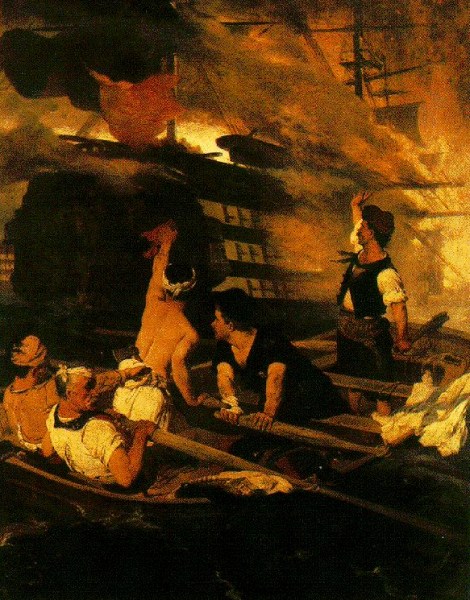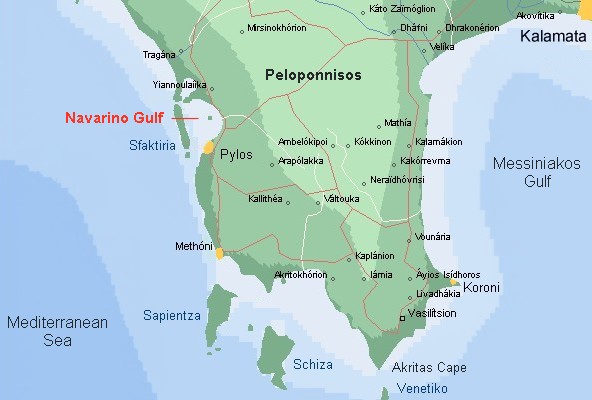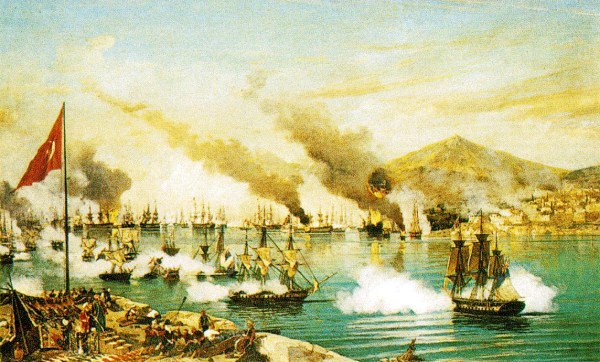The Navarino Sea Battle
October 20, 1827

The Navarino Sea Battle
October 20, 1827

Mnogaya Leta
Liberta
The British Anthem
After the death of Emperor Alexander, his younger brother Nicolai became the Tzar of Russia. Nicolai did not wish to comply any more with the restrictions of the Holy Alliance policy. Being possessed by the old ideas of Peter the Great and Empress Ekaterina for a Russian expansion to the South, he left the position of neutrality with respect to the Greek revolution and was willing to help the Greeks, alone or in collaboration with other countries.
When this became evident, George Canning proposed a collaboration, aiming to control the Russian actions and the frustration of a Russian-Turkish war, which could have unpredictable consequences for the British interests. The British proposals were delivered to Nicolai by the Duke of Wellington - the victor of the Waterloo battle. The Russian Emperor agreed and a collaboration protocol was signed in Petersburg (4.4.1826) to regulate the solution of the Greek problem. When Wellington was back, Canning had to discover that this was a document engaging Great Britain rather than Russia. He was almost ready to negate it. Metternich called this protocol "a still-born child", while others characterised it as a "product of mutual deception".
As time passed with no further actions, Nicolai declared its readiness to act "either alone or together with the Allies". To avoid the first, Canning proposed to France, Austria and Prussia to join the Petersburg Protocol. The last two refused, but France, feeling itself diplomatically isolated after the defeat of Napoleon, agreed and insisted on reformulating the protocol to the degree of a military ally. This ally was signed in London (6,7.1827) and aimed at the foundation of a semi-independent Greek state, politically and financially controlled by the Turkish Sultan. They appealed to Turkey and Greece to stop any military actions and start negotiations related to the above plan. The Greek Government, after the suggestion of Ioannis Kapodistrias, agreed, but the Sublime Porte refused.
The only way left to the three "Protectors of
Greece" was to impose their will by the use of force. They decided to forward strong
naval forces to the Greek Seas, in order to enforce a cease-fire. The British Government
instructed the head of the Mediterranean Naval forces to avoid any conflict with the
militant parts. Sir Edward Codrington was not convinced that this could be possible in all
cases and asked the British Ambassador in Instanbul what he should do if attacked.
Stratford Canning took the personal risk to suggest "the use of guns as the last
resort".

When Codrington was informed that the whole Turkish-Egyptian
Navy has been gathered in the Navarino Gulf, he directed the British fleet there and
approached the region at the beginning of September. On September 20 the French fleet, led
by Derigny, arrived as well. After two days the two admirals visited the Turkish commander
Ibrahim pasha and informed him on the will of the three allies to impose the cease-fire.
"I am not a diplomat, but a soldier. I will obey the orders given to me" replied
Ibrahim. The admirals assured him for the same: if necessary, they would sink any Turkish
or Egyptian ship ignoring their instructions. Ibrahim promised to ask for new instructions
and stop temporarily any military actions.
The Russian fleet, under admiral Heyden, approached the region on October 13, after a four-month navigation from Crostand through Baltic Sea and Gibraltar. On October 17 the three admirals wrote a letter to Ibrahim, accusing him of violating the agreement, pointing the attrocities commited by his soldiers over the whole Peloponnisos territory. The letter was sent with the british colonel Cradok, but the Turkish negotiator refuses to accept it, on the pretext of ignoring the Ibrahim's location.
On October 19 Derigny visited Codrington on the British flagship "Asia". They discussed about the coming winter and the difficulties regarding the continuation of the blockade. Derigny proposed to enter the bay and cast the anchors next to the Turkish-Egyptian ships. They called Heyden and he agreed to the plan. They decided to enter the gulf as soon as the wind becomes fair. Being the elder, Codrington was given the command of the operation. During the next day he sent instructions to every ship regarding its actions. They were accompanied by the Nelson's words from the Trafalghar sea battle: "The captain is in the right place when he succeeds to position his ship next to an enemy's one". Although words of a British, they were used later by the British Government to accuse Codrington of provoking the Navarino battle.
The British fleet consisted of 13 ships, led by the
battle-ship "Asia". The French ships were 7, leaded by the battle-ship
"Siren". The Russian ships were 8, under the flagship "Azoff". These
28 ships had a force of 1298 guns and 17500 men. The Turkish-Egyptian fleet numbered 89
warior ships and 41 transporters. They had totally 2436 guns and 21900 men. The numbers
were on their side, but the quality of both the officers and the equipment of the allies
was superior by far.

On October 20, a wonderful fall day, the wind blows from
the west and admiral Codrington gives the signal. At 13:30 "Asia" passes in
front of Niokastro castle. A Turkish boat comes close. "Mohamed-bey demands from the
British admiral to stop entering the bay" shouts the leader. "Tell him, that I
came here to give and not to receive orders" is the answer of Codrington. At 14:20
"Asia" casts the anchors 250 meters next to "Guhu-Revan" - the Turkish
flagship. At 14:25 "Siren" does the same next to the Egyptiam frigate
"Ishania". The rest of the French ships are still entering the gulf, while the
Russian are still outside.
The wind calms down. Some 15000 of Egyptian soldiers are silently watching the movements
of the allied ships. The British frigate "Darmouth" stands against the burning
ships of the opponents, located in the Southern part of the gulf. Its commander sends a
boat to inform their leaders about the non-enemy character of this action. The Turkish
fire, kill the boatswain and hurt several others. At the same time an Egyptian frigate
shoots twice against "Siren" and kill a French soldier. Derigny responds with a
broadside from all the guns targeting "Ishania". This salvo started the
"Navarino thunderbolt", as they called later this famous sea battle.
The initial disposition was quite unfavourable for the navy of the allies. The enemy ships had a perfect shoe-like formation and could attack from many sides the ships which had not yet taken proper positions. "Guhu-Revan" fires its first broadside towards "Asia". Codrington sends Petros Mikelis to the Turkish flagship for a last peaceful negotiation. A fanatic Ottoman recognises its Greek clothes and kills him. "Asia" starts a fight against both flagships. The ship is seriously damaged, but Codrington stays uncovered on the deck and leads impassively the unequal battle. Through a hall in the clouds of smoke the Russian fleet is seen to enter the gulf. "Thank God" says the British admiral. At 15:50 "Azoff" takes position next to the Turkish flagship and begins to fire, giving some breath to "Asia". Soon "Guhu-Revan" is destroyed from the explosions. "Ishania", all in fire, moves of and runs into the coastal rocks. One by one the ships of the Turkish-Egyptian fleet are burned and/or sunk.
At 19:00, just before getting dark, all the guns quieten down. The Turkish-Egyptian fleet does not exist any more. The allies have lost many hundreds of people: 272 British, 198 Russians and 185 French are dead or heavily injured.
In its report for the battle Heyden writes: "The
harmonic way the allies acted was beyond any expectation. One would say that the minds of
all worked together and the ships belonged to one and the same nation". Similar is
the evaluation of Codrington in his report. John Russel has called the Navarino battle
"the most honest as long as the world lasts".
170 years later...
... in these same waters a large international
experiment finds its natural laboratory. This is the "Nestor" project - a giant
(kilometric) tower of large detectors arranged in order to explore the cosmic neutrinos.
The project is co-ordinated by Prof. Resvanis of the Physics Department of Athens
University. The divers adjusting the first stages of this unique construction can often
see the remains of sunken ships from the Navarino battle.
-